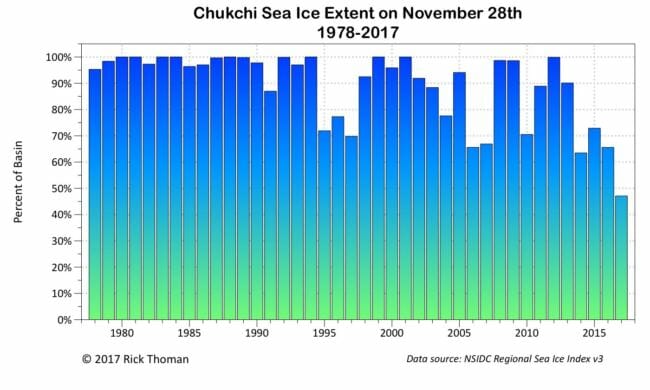
The Chukchi Sea should be almost fully covered in sea ice by now. Instead, it’s mostly open water.
Brian Brettschneider, with our Ask a Climatologist segment, says the ice coverage right now in the Chukchi is typical for mid-October, not late-November.
Interview Transcript:
Brian: Normally by this date, it’s 88 percent covered in ice. This year, it’s only 46 percent covered in ice. And that’s dramatically lower than even the second lowest year, which would be 2014, so very, very low ice coverage for this region…unprecedented.
Annie: And a record low by a wide margin…
Brian: By a very wide margin. I should say we’re talking the satellite era, which would be 1979 through present. But it’s fair to assume, and we have historical data that goes out to the late 1800s. It’s not as complete as the satellite era, but there’s really nothing even in that data set that comes close to where the sea ice is for 2017 through the end of November.
Annie: What does that mean for weather in Alaska?
Brian: Of course all the Arctic is very important, but because this area is adjacent to Alaska and because of the direction of the prevailing flow through much of the winter, it’s really important. Because that area, when it’s open water and it’s about 30 degrees it’s providing a lot of warmth to the atmosphere. When it’s covered in ice, that warmth is locked in underneath it. So if you have a flow of air that’s moving from say the Northwest, as it’s crossing over that water it’s going to be a lot warmer, if it’s locked in ice, it’s going to be a lot colder. It’s also going to be picking up a lot more moisture as it’s moving over the open water. So there’s a lot of local, near term weather impacts from having that open water.
Annie: Is there any ice near Utqiagvik?
Brian: Looking at the Geophysical Institute sea ice web cam, at least this morning there was no ice. There’s been a little bit of ice here and there, at the very nearshore. But basically there’s no ice up there at Utqiagvik. And talking to Rick Thoman, from the National Weather Service office, he’s indicated that in the last number of decades, the latest that it’s taken for the ice to fill in there is mid-November. So at least for the past 30, 40 and probably more years than that, this is the latest it’s ever taken to fill in the ice there in the nearshore areas.